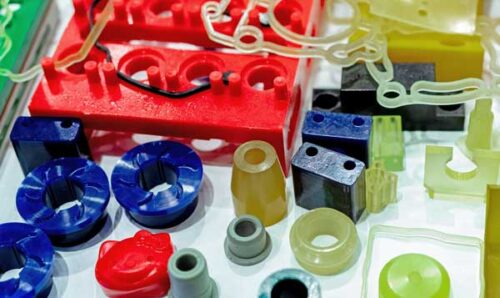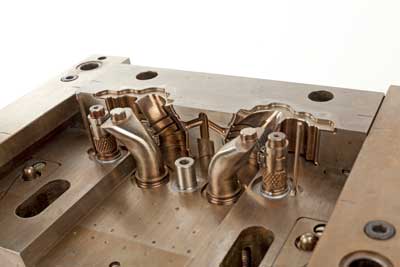
Plastic and rubber molded parts are everywhere, and are produced from an extensive array of materials. While the complete list contains hundreds of varieties, they fall into four basic categories: thermoplastic, thermoset, rubber and silicone. Each group has its unique set of characteristics, advantages, and applications. Due to the differences in their material properties, they also require different fabrication processes. Let’s dive in!
What Are Thermoplastics?
Thermoplastics are polymers that soften and become moldable once heated, then harden once cooled. Thermoplastics are the most widely used materials due to their extreme versatility and recyclability. They are known for being durable, and offer a wide range of properties due to the many polymers available. These include Polyethylene (PE), Polypropylene (PP), Polyvinyl Chloride (PVC), Polystyrene (PS), and Nylon.
 Molded thermoplastics may be worked using a few different methods: injection molding, blow molding, and extrusion. Injection molding involves heating plastic pellets to a molten state, injecting it into a mold cavity under high pressure, then allowing it to cool and solidify.
Molded thermoplastics may be worked using a few different methods: injection molding, blow molding, and extrusion. Injection molding involves heating plastic pellets to a molten state, injecting it into a mold cavity under high pressure, then allowing it to cool and solidify.
Blow molding is an entirely different process. Here, a tube-like piece of plastic, known as a parison, is inflated with air inside a mold to form hollow parts like bottles and containers. (It’s interesting to note that the parisons themselves are created by injection molding or extrusion.)
With the extrusion process, plastic pellets are melted then forced through a die to create continuous shapes. They are then cut to the required length.
Thermoplastic Applications
Chances are, if you’re thinking of a plastic component, it’s likely made from thermoplastics. They are used in countless commercial and consumer applications. Here are a few common ones:
- Injection Molding – automotive parts, packaging, electronic enclosures, medical components, and many household items.
- Blow Molding – bottles, containers, tanks, sporting goods (baseball bats), decorations, and other consumer items.
- Extrusion – pipes, sheets, films, and profiles.
Thermosets
 Thermosetting plastics, simply known as thermosets, are polymers that undergo a chemical change when heated, thus forming a rigid structure. Once set, they cannot be remelted or reshaped. When compared to thermoplastics, they are usually more stable, but also more brittle. Typical materials include Epoxy, Phenolic, Melamine, Urea-formaldehyde, and Polyester resins.
Thermosetting plastics, simply known as thermosets, are polymers that undergo a chemical change when heated, thus forming a rigid structure. Once set, they cannot be remelted or reshaped. When compared to thermoplastics, they are usually more stable, but also more brittle. Typical materials include Epoxy, Phenolic, Melamine, Urea-formaldehyde, and Polyester resins.
Thermoset molding processes involve the polymerization of the resin in the mold, which permanently sets it. Common manufacturing methods include compression molding, transfer molding, and injection molding designed specifically for thermosets.
With compression molding, a pre-measured amount of material, often in the form of powder or preform, is placed into the heated mold. It’s closed, then heat and pressure are applied to harden the material.
Transfer molding is similar to compression molding, but the material is preheated in a chamber before being transferred to the mold.
Finally, thermoset injection molding is very similar to thermoplastic with one key difference: the material undergoes a chemical reaction while curing, rather than just cooling down.
Thermoset Plastic Applications
Due to their unique characteristics, uses for thermoset plastics are a bit limited, but do excel for certain ones. In addition to adhesives, coatings, and composite materials, they are used for the following:
- Compression Molding – Electrical components, automotive parts, appliance housings, and large industrial parts.
- Transfer Molding – Precision parts, electrical components, automotive parts, and industrial equipment
- Thermoset Injection Molding – Precision parts, electrical components, automotive parts, and industrial equipment
Rubber Molding
 This process involves shaping rubber materials, which can be either natural or synthetic rubber (elastomers). Rubber has high elasticity and abrasion resistance with good tensile strength. These properties vary based on the type used, which include Natural Rubber, Neoprene, and Nitrile Rubber.
This process involves shaping rubber materials, which can be either natural or synthetic rubber (elastomers). Rubber has high elasticity and abrasion resistance with good tensile strength. These properties vary based on the type used, which include Natural Rubber, Neoprene, and Nitrile Rubber.
Common processing methods include compression molding, transfer molding, and injection molding. While these are similar to what is done for thermoplastics and thermosets, the process usually involves vulcanization. Here, the rubber is cured through heat and pressure usually with the addition of sulfur or other curatives to enhance durability and elasticity.
Molded Rubber Applications
Applications for rubber rely on its unique characteristics, they include:
Compression Molding – Seals, gaskets, large industrial parts, and tires.
Injection Molding – High-precision parts, seals, gaskets, and automotive components.
Transfer Molding – Electrical components, O-rings, seals, and more complex rubber parts.
Silicone
If you’re thinking, “Hey. Wait. Isn’t silicone a type of rubber?” – you’d be absolutely correct. However, silicone is processed a bit differently than other rubber types, and has earned its own category as a result. Silicone is widely known for its high heat resistance, flexibility, and biocompatibility.
Silicone also utilizes several processes including Liquid Silicone (LSR) Injection Molding, Compression Molding and Transfer Molding.
LSR Injection Molding is a specific yet simple process that uses liquid silicone rubber. It is poured into a heated mold, then cures quickly, taking the shape of the mold cavity. Compression molding uses High Consistence Silicone Rubber (HCR), often in sheets or preforms, which is placed into a heated mold cavity. Pressure is then applied to cure the silicone. Transfer Molding for silicone is similar to plastics: the silicone is preheated in a chamber then transferred to the mold cavity through a system of runners and gates, where it cures under heat and pressure.
Silicone Applications
Silicone is optimal for any product that require flexibility, heat resistance and/or biocompatibility. Common uses include:
LSR Injection Molding – Medical devices, kitchenware, baby products, and automotive parts.
Compression Molding – Seals, gaskets, and large silicone parts.
Transfer Molding – Complex silicone parts with fine details.

Comments are closed